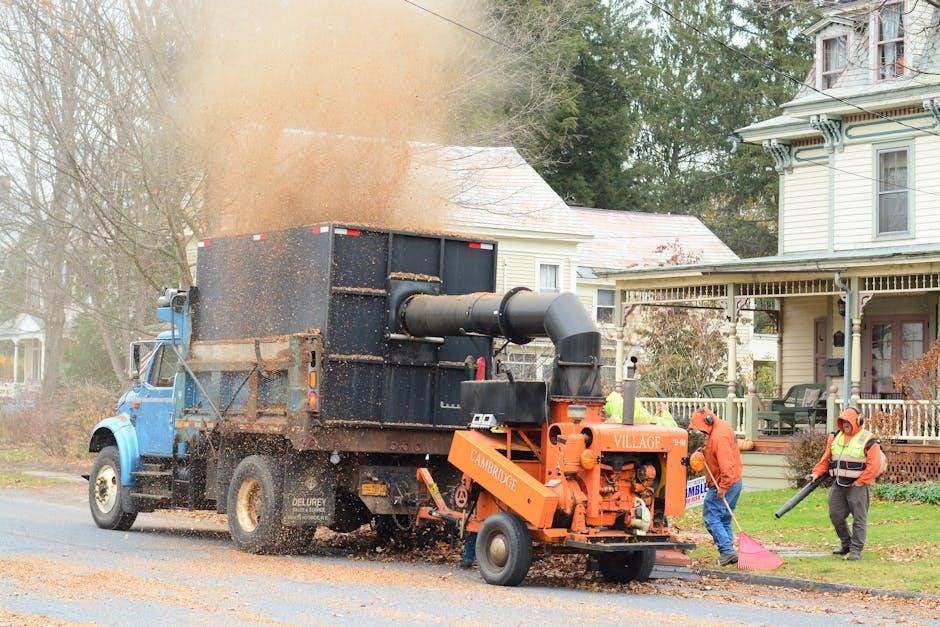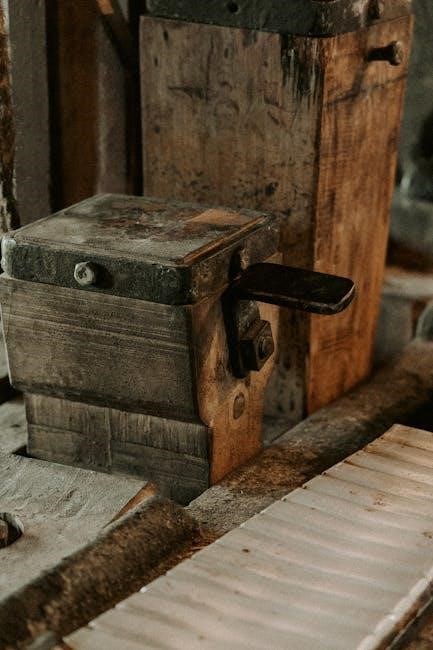
Manual Push Vacuum: A Comprehensive Guide
A manual push vacuum offers a non-electric cleaning solution, relying on human power to operate. These devices often utilize rollers or brushes that rotate when pushed, collecting dirt into an integrated container. They are perfect for quick cleanups.
Definition and Functionality
A manual push vacuum, also known as a manual sweeper, is a non-electric cleaning device designed to collect dirt and debris from various surfaces. Unlike electric vacuum cleaners, manual push vacuums rely solely on human power for operation. The user pushes the device across the floor, which activates rotating brushes or rollers.
These brushes sweep the dirt and debris into an internal collection container. This eliminates the need for cords, batteries, or electricity, making them a more eco-friendly and economical cleaning option. Manual push vacuums are designed for easy maneuverability in tight spaces and are often lightweight and easy to use.
Functionally, they provide a quick and versatile cleaning solution for messes like crumbs, pet hair, or cereal. They are suitable for use on various floor types and are particularly useful in areas where a traditional vacuum cleaner might be inconvenient or impractical. They are very quiet and will not disturb anyone while in use.

Historical Overview of Manual Vacuum Cleaners
The invention of the manual vacuum cleaner dates back to the second half of the 19th century, with patents being granted to inventors across the United States, Britain, and France. These early models were non-electric, using human muscle power to create suction and remove dirt from carpets and floors. They operated through pumping actions or bellows.
These devices represent a significant step in cleaning technology, offering an alternative to traditional brooms and manual sweeping methods. These early manual vacuums were crucial in paving the way for the development of more advanced cleaning appliances. They were designed to be more efficient at removing dust and debris, improving household hygiene.
Over time, these original designs were refined and improved, leading to the development of manual sweepers that utilize rotating brushes to collect dirt into an integrated container. The manual push vacuum has maintained its relevance in the cleaning world, thanks to its simplicity, eco-friendliness, and ease of use.
Key Features and Components
Manual push vacuums are designed with simplicity and functionality in mind. A primary feature is the rotating brush system, which consists of one or more brushes that spin as the device is pushed across the floor. These brushes sweep up dirt, dust, and debris efficiently. The collected material is then deposited into an integrated container, which is easily emptied.
The body of a manual push vacuum is typically lightweight, making it easy to maneuver in tight spaces and under furniture. The handle is designed for comfortable gripping and pushing, allowing users to clean effectively without straining themselves. Adjustable height settings on some models allow for use on various floor types.
Some manual push vacuums also include edge brushes, which extend beyond the main body to reach corners and along walls. These features ensure a thorough cleaning experience. The absence of cords or batteries makes these vacuums instantly ready for use, providing a quick and convenient cleaning solution.
Advantages of Using a Manual Push Vacuum
Manual push vacuums offer several distinct advantages, starting with their eco-friendliness. They require no electricity, making them a sustainable choice for environmentally conscious users. This also translates to cost savings, as there are no electricity bills or battery replacements to worry about.
Another significant benefit is their quiet operation. Unlike electric vacuums, manual push vacuums produce minimal noise, making them ideal for use in noise-sensitive environments or during times when quiet is preferred. They are also incredibly convenient; with no cords to untangle or batteries to charge, they are always ready to use for quick cleanups.
Their lightweight design and easy maneuverability make them suitable for cleaning tight spaces, corners, and under furniture. Manual push vacuums are also easy to store, requiring minimal space. Finally, their simple mechanical design ensures durability and reduces the likelihood of breakdowns, making them a reliable cleaning tool.
Disadvantages Compared to Electric Vacuums
While manual push vacuums offer numerous advantages, they also have limitations when compared to electric models. One of the primary drawbacks is the increased physical effort required. Cleaning with a manual vacuum demands more exertion, making it less suitable for large areas or individuals with mobility issues.
Another disadvantage is the generally lower suction power. Electric vacuums typically offer significantly more powerful suction, enabling them to pick up embedded dirt and debris more effectively. This difference in power can make manual vacuums less effective on thick carpets or heavily soiled surfaces.
Furthermore, manual vacuums often lack the advanced features found in electric models, such as HEPA filters, multiple attachments, and adjustable settings. The cleaning path of a manual vacuum is often narrower, requiring more passes to cover the same area as an electric vacuum. For deep cleaning or large-scale tasks, electric vacuums remain the superior choice due to their power and versatility.

Types of Flooring Suitable for Manual Vacuums
Manual push vacuums are versatile cleaning tools, but their effectiveness varies depending on the type of flooring. They excel on hard surfaces like tile, laminate, and hardwood. The brushes or rollers efficiently sweep up dust, dirt, and debris without causing scratches. These vacuums are particularly useful for quick cleanups in kitchens, bathrooms, and hallways.
On low-pile carpets and rugs, manual vacuums can also perform adequately. They can effectively remove surface-level dirt and pet hair. However, for thicker carpets, their performance diminishes as they may struggle to reach deeply embedded particles.
Manual vacuums are less ideal for high-pile carpets, shag rugs, or delicate flooring like some natural stone surfaces. The lack of strong suction and the potential for brush damage make them unsuitable for these materials. It is crucial to consider the flooring type when choosing a cleaning method.
Adjustable brush pressure can enhance the adaptability of manual vacuums, making them more effective on various surfaces; Always test in an inconspicuous area first.
Maintenance and Care Tips

Proper maintenance is essential to prolonging the life and efficiency of your manual push vacuum. Regularly empty the dust collection container to prevent it from overfilling, which can reduce suction power and overall performance. This simple step ensures that the vacuum continues to operate at its best.
Inspect the brushes or rollers frequently for tangled hair, threads, or debris. Remove these obstructions to maintain smooth operation and prevent damage to the flooring. Cleaning the brushes regularly will also improve the vacuum’s ability to pick up dirt and dust effectively.
Check the wheels for any obstructions or damage. Ensure they rotate freely to allow for easy maneuverability. Lubricate the wheels if necessary to maintain smooth movement.
Store the vacuum in a dry place to prevent rust or corrosion. Avoid exposing it to extreme temperatures or direct sunlight. By following these simple maintenance tips, you can keep your manual push vacuum in excellent condition for years to come.
Top Manual Push Vacuum Models on the Market
Several manual push vacuum models stand out for their performance, durability, and user-friendly design. The Bissell Natural Sweep Carpet and Floor Sweeper is a popular choice, featuring a dual brush rotating system and corner edge brushes for effective cleaning. Its lightweight design and ease of use make it ideal for quick cleanups on various floor types.
The Dirt Devil Simpli-Sweep offers a convenient grab-and-go solution for daily messes. Its cordless and bagless design eliminates the need for charging or replacing bags, making it a practical option for busy households.
The JEHONN Carpet Floor Sweeper with Horsehair is another notable model, known for its gentle yet effective cleaning action. Its horsehair brushes are suitable for delicate floors and carpets, providing a thorough clean without causing damage.
These top models showcase the versatility and efficiency of manual push vacuums, offering reliable cleaning solutions for a range of needs and preferences.
Applications in Various Settings

Manual push vacuums find practical applications in diverse settings, offering versatile cleaning solutions where electric vacuums may be less convenient or suitable. In restaurants, these sweepers provide a quiet and efficient way to clean carpets and floors during meal rushes, minimizing disturbance to guests. Their portability and ease of use make them ideal for quickly addressing spills and messes.
For caretakers and tradesmen, manual sweepers are valuable tools for maintaining cleanliness in courtyards, paths, workshops, and halls. Their ability to sweep thoroughly, even in corners, makes them perfect for cleaning large areas quickly and effectively.
In warehouses, hallways, and parking lots, manual push sweepers offer a practical solution for lifting trash and debris. Their robust design and ease of maneuverability make them suitable for both interior and exterior use.
Furthermore, manual sweepers are beneficial in homes, particularly for quick cleanups on stairs, under furniture, and in areas where cords from electric vacuums may be cumbersome. Their eco-friendly operation and quiet performance make them a versatile choice for various cleaning tasks.